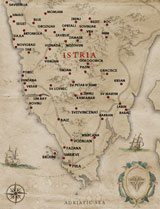to enlarge


or choose the place
from the menu below
 Rome |
 Byzantium |
 Venice |
 Vienna |
 Brioni |
 Smrikve |
 |
 |
Some other sources indicate that they might have bought it from the Lord of Sovinjak. Historically Sumber was part of Labin but after 1367 passed to the County of Pazin.
Schomberg family owned the castle until the end of the 14th century. Later on when Anna Schomberg married with Giovanni Guteneck, the Lord of Kozljak, and the castle became a part of Lords’ of Kozljak properties.
During the 15th century the castle was sold to the Lords of Krsan and later on to the family Herberstein from Lupoglav.
In 1420 Venetians occupied Sumber but they also accepted the offer of Lord of Krsan to buy the village. Later on Sumber was part of Lupoglav’s properties.
Sumber was also involved in the Uskoci war, between Venice and Austria, at the beginning of the 17th century. In the 17th century the castle was owned by Brigido from Trieste, that was also the Lord of Lupoglav. This family continued to own the property until the end of feudalism in 1848. Later on became a part of Krsan’s municipality and followed the destiny of other Istrian towns and villages.
After the First World War and fall of the Austro-Hungarian Monarchy, Sumber, was part of Italy, while after the Second World War became part of Yugoslavia (Croatia).
During the Italian Fascist period in Istria many Istrian families suffered from the regime or had to leave Istria. Fascism in Istria applied various repressive measures mostly towards Slav populations and this created the Antifascist Movement. The Second World War was a very painful experience for the Istrian population and many innocent Istrians, both Slav and Latin, died during that war.
After the second World War Sumber became part of Yugoslavia (Croatia). There were three agreements between Yugoslavia and Italy which established that Istria would become a part of Yugoslavia: Paris Agreement of 1947, London Memorandum of 1954 and the Osimo Agreement reached in 1975. In the first decade after the Second World War many Istrians, especially those living in towns and villages that for centuries were part of the Venice Republic, decided to leave Istria.
In 1991 with the fall of Yugoslavia and the founding of the Republic of Croatia, the internal republic boundaries were recognised as the state boundaries and Sumber is today part of Croatia.
In 2013 Sumber became part of the European Union. You can not change the past but you can try to learn from it. The main aim of the European Union founders was to build a system that could avoid future wars and future refugees in Europe as I explain in COSMOPOLITE.